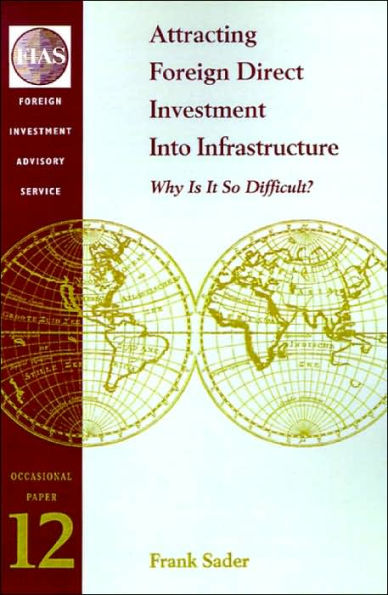| Abstract | vii |
| Preface | ix |
| Acknowledgment | xi |
| Abbreviations and Acronyms | xiii |
| Executive Summary | xv |
| 1. | Introduction | 1 |
| 2. | Foreign Direct Investment--The Engine Behind the Private Infrastructure Revolution | 6 |
| 3. | The Complex Nature of Greenfield Investments in Infrastructure: Incentives and Risks | 17 |
| 3.1 | The Contractual Web of a BOT-Type Project | 19 |
| 3.2 | Governments: Balancing Domestic Interests and Multiple Objectives | 23 |
| 3.3 | Sponsors: Creating a Viable Project Structure | 24 |
| 3.4 | Commercial Lenders--The Market Test of Bankability | 26 |
| 4. | Risks Investors Face | 28 |
| 4.1 | Conflicting Opinions Within Government | 32 |
| 4.2 | Insufficient Coordination | 33 |
| 4.3 | Insufficient Expertise | 37 |
| 4.4 | Direct Negotiations versus Competitive Tenders | 41 |
| 4.5 | Unclear Tendering Rules | 45 |
| 4.6 | Political Interference | 49 |
| 4.7 | Unclear Market Entry Conditions | 50 |
| 4.8 | Lack of an Adequate Legal Framework | 52 |
| 4.9 | Difficulties During Operation | 57 |
| 4.10 | Social Concerns After the Fact | 61 |
| 4.11 | Political Commitment of Successor Governments | 63 |
| 5. | Handling the Risks | 69 |
| 5.1 | The Role of Government Support Arrangements | 70 |
| 5.2 | The Importance of Overall Sectoral Liberalization | 79 |
| 6. | Designing an Effective Policy Framework | 88 |
| 6.1 | The Usefulness of an Institutional Support Structure | 89 |
| 6.2 | Designing an Overarching Legal Framework | 102 |
| 6.3 | Regulating Private Infrastructure: Minimizing Risk and Abuse | 122 |
| 6.4 | The End Result: Expensive Potentials or Investment Booms | 128 |
| 7. | The Impact of the Asian Crisis | 132 |
| 8. | Conclusion | 145 |
| Annex I. | Methodology for Estimating FDI Flow | 147 |
| Annex II. | Summary Data Tables | 155 |
| Notes | 169 |
| References | 171 |
| Figures | |
| 1. | Number of Private Infrastructure Transactions in Developing Countries | 7 |
| 2. | FDI Inflows to Developing Countries from Infrastructure Projects | 11 |
| 3. | FDI in Infrastructure, by Sector | 12 |
| 4. | Different Strategies: Latin America and East Asia Compared | 13 |
| 5. | Investor Origin, by Sector | 15 |
| 6. | Actual Versus Potential Private Infrastructure Projects | 18 |
| 7. | Structure of a BOT-Type Project | 20 |
| Tables | |
| 1. | FDI Is Key in Private Infrastructure in the Developing World | 9 |
| Boxes | |
| 1. | What Is a "BOT-Type" Project? | 3 |
| 2. | The Trouble with Traffic Forecasts: The Dulles Greenway | 29 |
| 3. | Project Preparation Is an Expensive Business | 30 |
| 4. | Fighting State Monopolies: The Story of Econet | 34 |
| 5. | Conflicting Authorities: The Subic Bay Container Terminal | 36 |
| 6. | How Not to Do It: Mexican Tollroads | 38 |
| 7. | Good Preparation Is Key: Airport Projects in Eastern Europe | 40 |
| 8. | Dabhol: The Dangers of Direct Negotiation | 42 |
| 9. | Privatization, Russian Style | 46 |
| 10. | Privatizing Brazil's Telecommunications Sector | 48 |
| 11. | Zimbabwe's Hwange: Politics and Business | 50 |
| 12. | China's Telephones: The Power of State Monopolies | 52 |
| 13. | The Value of Old Promises: Poland's Cellular Licenses | 54 |
| 14. | The Costs of a Shaky Legal Framework: Turkey | 55 |
| 15. | BOTs in China: A Slow Road to Progress | 58 |
| 16. | The Question of Government Reliability: Hungary's Electricity Privatization | 60 |
| 17. | Full-Scale Privatization: British Rail | 62 |
| 18. | Who Pays the Toll? Portugal's Vasco da Gama Bridge | 64 |
| 19. | The Risk of Politics: Venezuela's CANTV | 65 |
| 20. | Pakistan's IPPs: How Reliable Are Sovereign Guarantees? | 66 |
| 21. | Trouble with Sub-Sovereign Authorities: Tucuman Water | 68 |
| 22. | Country and Project Risks | 72 |
| 23. | Types of Government Support Arrangements | 76 |
| 24. | Managing Contingent Liabilities | 78 |
| 25. | Excess Capacity Through Private Competition: Argentina's Electricity Reform | 82 |
| 26. | Indian Electricity: The Lack of Sectoral Reform | 84 |
| 27. | Dealing with the Entire Network: Argentinean Rail Concessions | 86 |
| 28. | The N-4 Tollroad: A First Success in Africa | 90 |
| 29. | Developing a Procurement Process: Britain's Private Finance Initiative | 96 |
| 30. | The Power of International Arbitration: Grenada Electricity | 121 |
| 31. | The Role of a Strong Regulator: The Experiences of Argentina and Peru | 123 |
| 32. | Hungary's Energy Office: Autonomy without Authority | 124 |
| 33. | How to Make a BOT Really Expensive: The Example of an African Bridge | 129 |
| 34. | The Philippines: Averting a Crisis Through Private Power | 131 |
| 35. | Thailand's BERTS Saga | 134 |
| 36. | Fallout from the Currency Crisis: Indonesian IPPs | 136 |
| 37. | The Importance of Government Support: The Experience of Hungarian Tollroads | 140 |
| 38. | Multilateral Support for Private Infrastructure Projects | 142 |




